
Headache Treatment Page Menu: 1 2 3 4 Next>>
Treating Headaches During the Golden Age of Piracy, Page 1
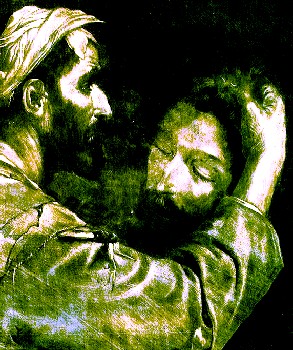
Artist: Prince Rupert of the Rhine (1658)
"Headache is pain in any region of the head. Headaches may occur on one or both sides of the head, be isolated to a certain location, radiate across the head from one point, or have a vise-like quality. A headache may be a sharp pain, throbbing sensation or dull ache. Headaches may appear gradually or suddenly, and they may last less than an hour or for several days." (Headache, Mayo Clinic Website, gathered 12/1/14)
We have all experienced headaches to one degree or another, sometimes accompanying other health problems, sometimes as independent problems all their own. From the dawn of man, there have almost certainly been headaches. From the dawn of headaches, there have almost certainly been attempts to treat them. This was as true during the golden age of piracy as it is today.
With that in mind, we are going to look at the causes of headaches and migraines during this time and the remedies used to treat them including bloodletting, setons and medicines along with some other attempts to curing them.
Headache Causes
A variety of things were believed to cause headaches at this time. Among them were the type of air the person was breathing, various food and drink and health problems such as fevers, measles, tumors and venereal diseases.
Headache Causes - Air
The air that a person breathed was thought to have a great deal of impact on their health. For seamen, swampy areas, fogs and foul-smelling air were all believed to be possible causes of illness. Headaches were one of many illnesses that were felt to result from unwholesome air.
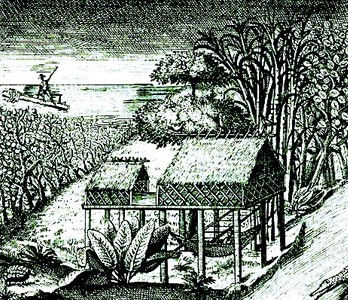
House on the Guayaquil River (1748)
While in Guayaquil, Ecuador in 1684, buccaneer William Dampier reported, "The Country is subject to great Rains, and very thick Fogs, especially the Valleys. For that reason it is very unwholsome and sickly. The chiefest Distempers are Fevers, violent Head-ach, Pains in the Bowels, and Fluxes [diarrheas]."1
At the island of Lobos in 1709, Woodes Rogers reported that the "Wind always blowing fresh over the Land, brought an ugly noisom Smell aboard from the Seals ashore, which gave me a violent Head-Ach, and every body else complain’d of this nauseous Smell"2.
Vapors from burning coal were also reported to cause headaches. While reporting on the cause of death of three men, French surgeon Ambroise Paré explained that "the vapor proceeding from the burned coals, which being in a place void of all air or winde, infer's such like accidents as the vapor or must of new wine doth, that is to saie, pain, and giddiness of the head. For both these kinds of vapor besides that they are crude, like unto those things whereof they com, can also verie suddenly obstruct the original of the Nervs, and so caus a convulsion, by reason of the grossness of the substance."3
Country physician Stephen Bradwell likewise reported it "dangerous to be in a little roome with the doores and windows shut, where there is a panne or furnace with fire in the middle of the roome: especially while the Coales are kindling, or the Fornace but newly made is annealing. For the vapour & smoake stifleth suddainly, before it be suspected of perceived. ...venting of the ill ayre out, and the receiving of the fresh ayre in, is both the Prevention and Cure of this Accident. But commonly there remaineth an head-ach for a while after".4
1 William Dampier, Memoirs of a Buccaneer, Dampier’s New Voyage Round the World -1697-, p. 110; 2 Woodes Rogers, A Cruising Voyage Round the World, p. 83; 3 Ambroise Paré, The Workes of that Famous Chirurgion Ambrose Parey, p. 757; 4 Stephen Bradwell, Helps For Suddain Accidents Endangering Life, p.107-8
Headache Causes - Food and Drink
Certain foods and drinks were associated with headaches in period literature. In his Pharmacopoeia, Nicholas Culpeper reported that a number of foods and herbs ingested caused headaches including Onions1, Eruca sativa2 (garden rocket) and Schizanthus3 (butterfly flower).

"Tastes OK to me!"
Alcohol was an obvious candidate for instilling headaches, as anyone who has drunk to excess knows the morning after. When discussing 'all strong liquors and sugars', sea surgeon John Atkins noted that "Nature kindly forwarn[s] us by the Head-achs, Indolence and sick Stomachs, created on our Indulgence and Satiety; the Steps we are taking to rivet on our Constitutions greater Evils."4
Ambroise Paré warns against a less toxic liquid for some people: donkey milk. First he extols its virtue in treating consumption, ulcers of the lungs and gnawing in the stomach. He goes on to explain, "for that all [people's] natures cannot away [tolerate] with Asses milk, such shall abstain from it, as it makes to have acrid belchings, difficulty of breathing, a heat and rumbling in the Hypochondria, and pain of the head."5
Water was also blamed for causing pain in the head. While searching for a fresh water source to refill his ship's water casks when he was near Macau, China, Captain Alexander Hamilton reported,
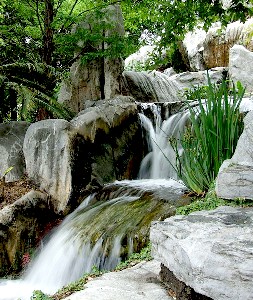
Photo: Andrew McMillan
A Stream Over Rocks in China
(Probably Not the Same One)
I saw a fine clear Stream trickling down the Face of a Rock, about half a League from our Ship. I ordered my Men to fill about 20 Tuns [casks or barrels - probably about 256 gallons each] of it, and being clearer than we had before, we made use of it, for drinking and boiling Rice. About 10 Days after we made Use of it, all my Men were affected with a violent Head-ach, and, among the rest, myself, which was a Distemper I never had been troubled with before.
I began to suspect that the Water might be the Cause, and ordered a large Copper-pot to be filled with it, and to boyl one Half of it away, and set the rest to Cool a day and a Night, which was accordingly done, and, on pouring off this water, I found a large Handful of a dark gray salt at the Bottom, of a sharp unsavoury Taste, which made me empty what remained of it into the Sea…6
It is interesting that Hamilton went to such great lengths to discover the source of the problem with the water. His curiosity about this didn't end there. Some time later, he discussed the situation with a Portuguese physician, who told him "most of the Springs in China had pernicious Qualities, because the subterraneous Grounds were stored with Minerals, as Copper, Quick-silver [mercury], Allom [alum], Toothenague [a type of Zinc], and &c. and the Springs running thro’ or near those Mines, the Water becomes affected with their natural Qualities, which was one Reason why the Chinese boyl’d all their Water before they drank it"7.
1 Nicholas Culpeper, Pharmacopœia Londinesis, p. 3-4; 2 Culpeper, p. 27; 3 Culpeper, p. 37; 4 John Atkins, The Navy Surgeon, p. 131; 5 Ambroise Paré, The Workes of that Famous Chirurgion Ambrose Parey, p. 300; 6 Alexander Hamilton, British sea-captain Alexander Hamilton's A new account of the East Indies, 17th-18th century, p. 487-8; 7 Hamilton, p. 488
Headaches Accompanying Other Issues
Headaches frequently accompany other health problems, as several period surgeons and physicians noted in their books.
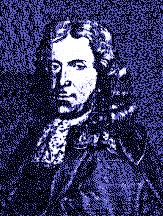
Matthias Gottfried Purman
Some of them make perfect sense to us today. German military surgeon Matthias Gottfried Purmann mentions a headache accompanying a sword wound to the head. When the headache persisted for almost two weeks, Purmann used this symptom, along with some others, to convince himself that trepanning (cutting a hole in) the patient's skull was necessary. As a result, "in less than an hour’s time all the ill Symptoms vanished again"1.
French surgeon Ambroise Paré discusses headaches in conjunction with eye problems. He explains that incurable cataracts can be accompanied "by most bitter and cruel pains of the head"2. He also notes that when Opthalmia (inflammation of the eye) produces "a hot pain trouble the forehead, the diseas may bee thought to proceed from som hot distemper of the Duramater [dura mater - membrane surrounding the brain], or the pericranium [the membrane (also called the periosteum) encasing the skull]."3
Dental surgeon Charles Allen mentions headaches in conjunction with toothaches, something most people can appreciate. However, his explanation as to why the headache occurred will sound quite bizarre. He explains that 'depraved' blood diffusing through the brain gets stuck in the skull, where "if not timely discharged of their malignant and offensive Corpuscles, (through the usual Emunctories [cleansing]) will either by their fermentation in the Ventricles [hollow areas] of the Brain, cause an Head-ake; or by the oppilation [filling] of its pores, cause a giddiness; or else passing out of the Brain into the Nerves, will by their irregular motion... breed a disturbance in al the parts they go to; but more particularly in the Teeth, in which they always excite very great pains."4
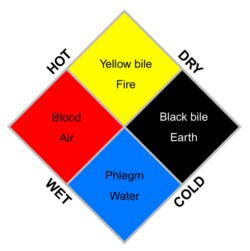
The Four Bodily Humors and Their Attributes
Allen's explanation is a verbose way of saying corrupted blood gets stuck in the head and causes pain. This is an example of humor theory, which was a working theory in medicine from the time of Hippocrates in 400 BC through the end of the 19th century. The body was thought to have four humors - phlegm, black bile, yellow bile and blood. When health issues occurred, they were a result of an imbalance or corruption of these humors. One of the typical remedies for bad humors was to bleed the patient to remove the corrupted or bad blood, a procedure used to treat headaches which we will revisit later in this article in greater detail.
Sea surgeon John Moyle discussed the problem of stopping a recurring violent nosebleed which was always preceded by a violent Headache using a humoral treatment. Moyle noted that the patient had "had most of the Common Means used to him to stop it", but they had failed. He bled the patient and blew powder up his nose which stopped the bleeding. Relying on the headache as a precursor to this problem, "when ever that Symptom came, he [the patient] took a Purge of Pil. Cochia. Minor. {2 scruples} which prevented Bleeding."5
Headaches were explained by other humoral theories as well. Apothecary Nicholas Culpeper attributed "pricking pains in the head" to too much choler (another name given to the humor black bile) and "pricking pains... about the temples" and headache to an overabundance of blood in the patient's body.6
While headaches accompanying the above health issues are interesting, they are only presented by a single author, suggesting that they were either not widely supported in the period medical literature under study or at least not widely commented upon. (Surely no one with a serious toothache can deny the fact that a headache sometimes accompanies it.) However, there are several other illnesses which are discussed by multiple authors, giving them broader support in the period medical literature of the time.
1 Matthias Gottfried Purmann, Churgia Curiosa, p. 11; 2 Ambroise Paré, The Workes of that Famous Chirurgion Ambrose Parey, p. 411; 3 Paré, p. 405; 3 Paré, p. 405; 4 Charles Allen, The Operator for the Teeth, p. 45-6; 5 John Moyle, Memoirs: Of many Extraordinary Cures, p. 43-4; 6 Nicholas Culpeper, Pharmacopœia Londinesis, p. 88

